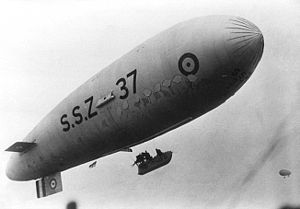
RNAS Capel
Encyclopedia
Royal Naval Air Station Capel (later Royal Air Force Station Folkestone) was a First World War airship station near Folkestone, Kent.
were seen as ideal location for a base and work started in April 1915. Although not completed the base was official opened on 8 May 1915. The first airship for Capel was to have been SS-1 the first of a new sea scout class
of non-rigid airships, on delivery to Capel from RNAS Kingsnorth
on 7 May it hit telegraph wires and was destroyed. Despite the accident more sea scouts were soon delivered to Capel.
 Following the successful repair to SS-10 at Capel production of the airships moved from Kingsnorth to Capel, although by 1916 production had moved again to Vickers at Barrow and RNAS Wormood Scrubs. The engineering section at Capel went on to design an improved variant of the SS airship which would be known as the SSZ
Following the successful repair to SS-10 at Capel production of the airships moved from Kingsnorth to Capel, although by 1916 production had moved again to Vickers at Barrow and RNAS Wormood Scrubs. The engineering section at Capel went on to design an improved variant of the SS airship which would be known as the SSZ
. The SSZ had an improved aluminium covered ash-framed car and was fitted with a 75hp Rolls-Royce Hawk
aero-engine, it was fitted with a 70000 cu ft (1,982.2 m³) envelope and test flown in August 1916. When the Admiralty were informed about the new airship they censured the air station for carrying out unauthorised modifications, but on the other hand ordered the type into production.
officer depth-charged and sunk submarine UB-103.
Two sub-stations were used at Godmersham Park north of Wye and Wittersham south of Tenterden were active. The sites were used as mooring-out bases where the airships could be secured in a sheltered area.
History
When Germany declared in February 1915 that it would commence unrestricted submarine warfare the Royal Navy responded with the building of airship stations around the coast. Being close to the Dover straight the open fields east of Capel-le-FerneCapel-le-Ferne
Capel-le-Ferne , the name of which derives from the phrase "Chapel in the Ferns", is a village situated near Folkestone, Kent. It has a population of approximately 2400...
were seen as ideal location for a base and work started in April 1915. Although not completed the base was official opened on 8 May 1915. The first airship for Capel was to have been SS-1 the first of a new sea scout class
SS class blimp
SS class blimps were simple, cheap and easily assembled small non-rigid airships that were developed as a matter of some urgency to counter the German U-boat threat to British shipping during World War I...
of non-rigid airships, on delivery to Capel from RNAS Kingsnorth
RNAS Kingsnorth
RNAS Kingsnorth was a First World War Royal Navy air station for seaplanes and airships, mainly operating as an experimental and training station, but also providing anti-submarine patrols...
on 7 May it hit telegraph wires and was destroyed. Despite the accident more sea scouts were soon delivered to Capel.
Airship production

SSZ class blimp
|-See also:-External links:*...
. The SSZ had an improved aluminium covered ash-framed car and was fitted with a 75hp Rolls-Royce Hawk
Rolls-Royce Hawk
|-See also:-Bibliography:*Flight 7 May 1954**Lumsden, Alec. British Piston Engines and their Aircraft. Marlborough, Wiltshire: Airlife Publishing, 2003. ISBN 1-85310-294-6....
aero-engine, it was fitted with a 70000 cu ft (1,982.2 m³) envelope and test flown in August 1916. When the Admiralty were informed about the new airship they censured the air station for carrying out unauthorised modifications, but on the other hand ordered the type into production.
Operations
The airships carried out patrols along the English coast and escorted shipping across the channel always on the look out for submarines. In April 1918 the Royal Air Force was formed and Capel became RAF Folkestone, it had by then three large airship sheds and a grass landing area. On 16 September 1918 SSZ.1 while under the command of a United States NavyUnited States Navy
The United States Navy is the naval warfare service branch of the United States Armed Forces and one of the seven uniformed services of the United States. The U.S. Navy is the largest in the world; its battle fleet tonnage is greater than that of the next 13 largest navies combined. The U.S...
officer depth-charged and sunk submarine UB-103.
Two sub-stations were used at Godmersham Park north of Wye and Wittersham south of Tenterden were active. The sites were used as mooring-out bases where the airships could be secured in a sheltered area.
Closure
Following the end of the First World War the station was closed in 1919. In the Second World War the site was used as a radio monitoring station.See also
- Battle of Britain Memorial, Capel-le-FerneBattle of Britain Memorial, Capel-le-FerneThe Battle of Britain Memorial is a monument to aircrew who flew in the Battle of Britain. It is sited on the White Cliffs at Capel-le-Ferne, near Folkestone, on the coast of Kent. It was initiated by the Battle of Britain Memorial Trust, and opened by the Queen Mother on July 9 1993...
on the other side of the village is a memorial to the RAF aircrew of the Battle of Britain.

